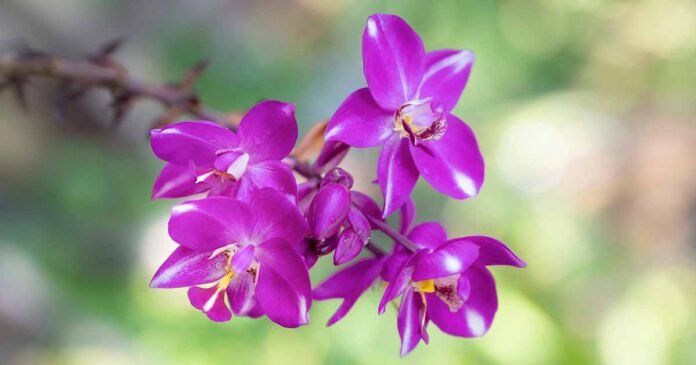Hybrids and cultivars derived from this species are especially popular, with ‘Adams,’ ‘Crownfox,’ and ‘Solarflare’ among the standouts.
Maintenance
There’s very little maintenance with these plants. Trim off damaged, diseased, or pest-infested leaves as you see them.
When the flowers have faded, you can remove the flower stalk by cutting it off at the base or one inch above the base using a sanitized knife or pruners.

Replace the potting soil every three years, as the soil tends to break down, become compact and depleted, and sometimes even hydrophobic.
To do this, remove the plant and dump out the existing soil. Brush the excess soil from the roots.
Clean out the container with hot, soapy water and repot the orchid in fresh potting medium.
Outdoor plants don’t need any help to rebloom.
But indoor-grown Spathoglottis may need a little extra attention to encourage flowering. You can learn how to do that here.
Propagation
Orchid propagation is a wild, wild world. Talk to one grower and they’ll tell you one thing. Talk to another and they’ll tell you the exact opposite works for them.


Most serious orchid enthusiasts practically have a laboratory in their greenhouse where they work like mad scientists.
That’s probably why many of us leave the propagation to the experts and just buy our specimens.
But I can say from personal experience that if you go in with an open mind and a sense of adventure, you never know what you’ll end up with. You have nothing to lose, right?
From Seed
Yes, you can grow orchids from seed.
But it’s complicated, time-consuming, and definitely not for beginners. You’ll need special equipment, lots of patience, and a clean environment.


If you’re feeling brave, we have a full guide to starting orchids from seed to walk you through the process. You’ll learn a lot about orchids and propagation in general!
From Stem Cuttings
When your orchid has finished blooming, don’t toss the flower stalk.
Cut it off at the base, and then make another cut just below the last spent flower. That’s your cutting. Discard the top section.
Depending on the length, you can divide the stalk into five- or six-inch pieces.
Dip the bottom end in rooting hormone, then wrap each piece in a moist paper towel. Place each wrapped section in a zipper bag, and set the bags somewhere warm, around 60 to 70°F, with bright, indirect light.
Keep the towels moist. If they start to turn dark or smell off, replace them.


